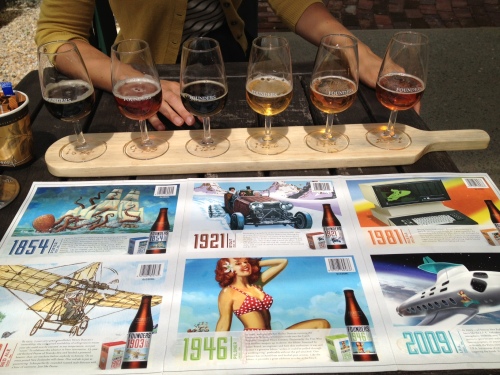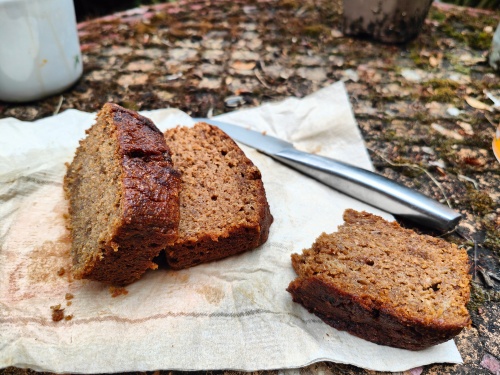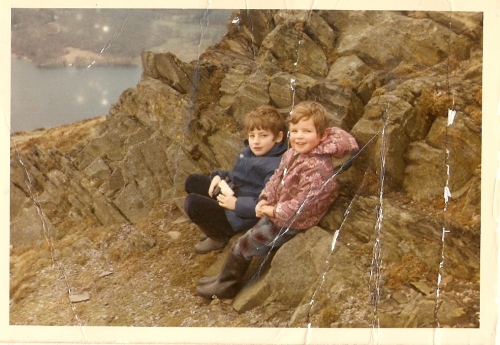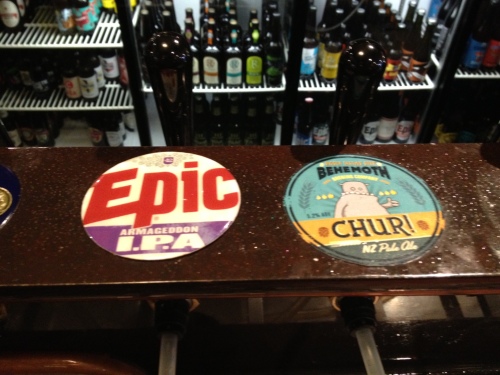
I love the city of Nelson, in Tasman Bay at the top of NZ’s South Island. It has a cathedral and a royal edict, so it can call itself a city, but really it’s just a quiet small town.
When I lived in NZ in my mid-twenties, it was where I came for a break from the intensity of the sandfly infested, bush-clad hills and cliffs of the Buller Gorge, with its reliable rains and very short window of sunlight opportunity in the winter. The sun always seemed to shine in Nelson. And indeed, when we drove up on Sunday night, after two days of torrential downpours on the West Coast and in the Buller, the clouds parted.
We’d had a lovely, though brief visit to the farm and old friends I used to live with, and we even managed an Italian-ish lunch, with pizza, caponata (south Italian artichoke stew) and carciofi alla romana (Roman-style artichokes; though without the Romanesco artichokes, it was a little challenging) but as we don’t have that much time on this trip, we wanted to move on: to Nelson, with its claim of being the Craft Brewing Capital of NZ, and its dozen or so breweries. And population of not much more than 50,000; my home town has 35,000 people and a big fat zero breweries.

Clear skies, empty stomach, free house
The clearing skies of Nelson were a welcome sight though. I dreamed of dry shoes and, enthused, we rushed out and started drinking beer. I thought the lunch would see us through, but my stomach was actually rather empty and the beer caught up with me. Oops.
Still, the venue was fantastic. The Free House is an ex-church on Collingwood Street in Nelson. Enter via a gate, past a large yurt (for events), and there’s the little chapel, with rendered walls and corrie iron roof.
It was a quiet Sunday evening, and the place reminded us a little of the village halls of our generation’s coming-of-age discos. Except for the giant cockroach sculptures on the wall. And the beer: 10 keg taps, three handpumps.
Stephen, the guy serving, said they’d been going since 2009 – so a few years after our last visit. The handpumps – which, he says are getting “more and more, more and more” attention from drinkers more used to the bubbles of kegs – were at this time all dedicated to Townsends, a independent local brewery, founded in 2005 and using Nelson hops and 25,000 year old water, “drawn up from over half a kilometre under the Moutere Valley Clay.”
We tried their JC IPA, which had nice resin, citrus, pine smells but a fairly mellow, malty taste. Nice medium body, but pretty minimal bitter crispness – a bit too mild for my idea of an IPA. Also Sutton Hoo, an “American amber ale” which was very rich and smooth.
When I asked Stephen for the most assertive beer they had on, he gave me a Volcano Red from Mata Brewery on the North Island. Fran also tried Mata’s Black Brew Stout. Both were great, but the former was 7% and really got me on the aforementioned empty stomach.
Brewing founders
The next day, my beer cravings had abated somewhat. So we first focussed on food, and culture. We visited a great Nelson bakery, the Swedish Bakery at 54 Bridge Street, and had some quality pastries for breakfast.
After some museum action, we headed out to Founders Heritage Park, a kind of Truman Show set with old NZ buildings, few hundred metres of train line, a recreation of a windmill, and a brewery, also called Founders.
It’s a brewery that’s been relaunched this year with some great artwork, but the standard of the branding made me a bit suspicious, as did the blurb’s insistence on saying things like “Spanning over 6 generations and almost twice as many brewers, Founders has been brewing beer in Nelson for almost 160 years”.

Indeed, dig a little deeper and it becomes clear there hasn’t exactly been 160 years of continuous, independent brewing. Indeed, from 1969 to 1999, they were owned by DB (one of the two big NZ brands). Between 1999 and 2012 they did seem to be an indie, at Founders Park and the “First fully certified organic brewery in the Southern Hemisphere and only one of six in the world.” In 2012, however, they sold to Boundary Road Brewery, which is itself part of the so-called Independent Liquor Group, which is part of Japanese drinks giant Asahi.
We did a taster of their six current brews and while they were all nice enough (albeit on tap and served too cold), some bordered on bland and the 2009 IPA was again a case of not enough hop bitterness.
Later on, we went to the State Cinema (where I’ve been seeing films since 1994), which has a pizzeria, Stefano’s, where the pizzaiolo is dubbed “The King of Pizza”. Maybe him and Rome’s Gabriele Bonci need a pizza-off. Stefano’s looked pretty awesome, though we’d just eaten elsewhere so didn’t sample.
After a film, we did managed one more beer (a half each) from one of the ever-increasing number of Sprig & Fern outlets. This is another Nelson small brewery brand, that is slowly but surely expanding, to Wellington, to Auckland. I tried their IPA, which was pleasant enough, but lacking in the hoppy bitterness. Again.
Return of the Mc
As I’ve said several times recently on this blog, between the ages of about 18 and 24, I didn’t drink, put off booze by bad 1980s corporate lager, which dominated the pubs of my teenage years. It was NZ’s Black Mac, a kind of schwarzbier (black lager), that subsequently got me interested in beer. So I felt I had to go to the new McCashin family brewery.

Terry McCashin, who first started brewing Mac’s beers in 1981 had sold his brewery – which really kicked off NZ craft beer – to Lion Nathan in 1999, killing its craft credentials. In 2009, though, his son, Dean, moved back into their original premises, the 1950s Rochdale Cider factory in Stoke, just outside Nelson, and started brewing again, as a fully NZ-owned operation.
Bravo. Kinda convoluted. But bravo.
The brewery has a great café and woman at the bar who greeted us was charming. The guy who guided us and five others was sweet too, though he didn’t introduce himself and seemed to struggle when questions took things off-script. He did have an interesting take on how to define “craft beer” though – “a craft will adhere to the materials – water, yeast, hops and malt”. So while industrial brewers can and do add sugars, craft brewers rely on the complex sugars from the malts.

He talked about how the brewery is producing beer (under the ‘Stoke’ brand), ciders, wine and is even embarking on vodka and whisky distilling. They also contract brew: we watched Moa bottles coming off the bottling and pasteurising line.
Yes, they filter and pasteurise. They also add CO2. The guide said the gas was to please the Kiwi taste for fizzier beer, but this seems to contradict what Stephen of the Free House was saying about their hand pumps. Plus, the guide also said that without pasteurisation beer wouldn’t have the longevity (“Lucky to get two weeks”), but this is contradicted by hundreds of traditional and craft brewers the world over who are bottle conditioning with live yeasts.
After a wander round the brewery, we tasted about a dozen Stoke beers. Now clearly these guys know their beer and know the beer business, but several of them seem fairly similar – mellow, malty, bubbly, not much in the way of bitterness or strong hoppiness.
Their most popular and garlanded beer, the Stoke Amber, is a really pleasant summer beer, but doesn’t have much character beyond a nice colour and a slightly strawberry smell. Their Lager, Pilsner and Gold are all fairly similar, and their Stoke IPA isn’t far off – it’s too mild to really stand out as an IPA. (Again.)
They do have more interesting beers, like the Cirrus Wheat, with its big banana smell and taste, and Smokey Ale, with its overtones of bacon-flavoured crisps or even kippers, and their Double Pale Ale finally has a bit of bitterness (it’s dry-hopped), but all in all, I found their wares a little underwhelming.

But then maybe nothing they could do would hold up against my memories of my 24-year-old self’s first revelatory experience of a rigger of Black Mac, filled up in a rough Murchison pub and drunk on the veranda of my friends’ place in the Buller.
So we drove on, leaving the other Stoke breweries – Lighthouse, Bays – for another day. Thankfully, on our way around Tasman Bay we went to another brewery, which really restored our faith in the NZ beer scene. But this post is getting far too long, and the view outside is far too splendid to ignore, so I’ll save that for another day.
Right, I’m off to see some glowworms.

































































